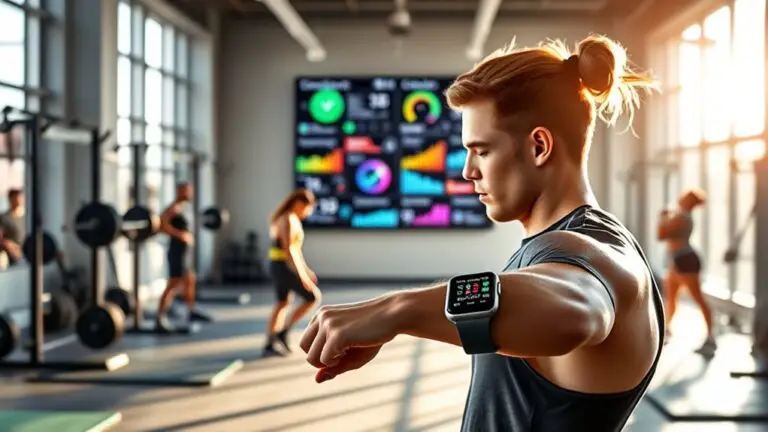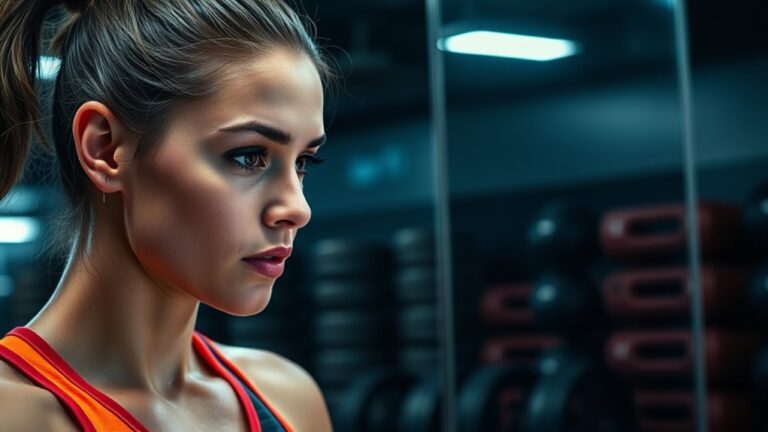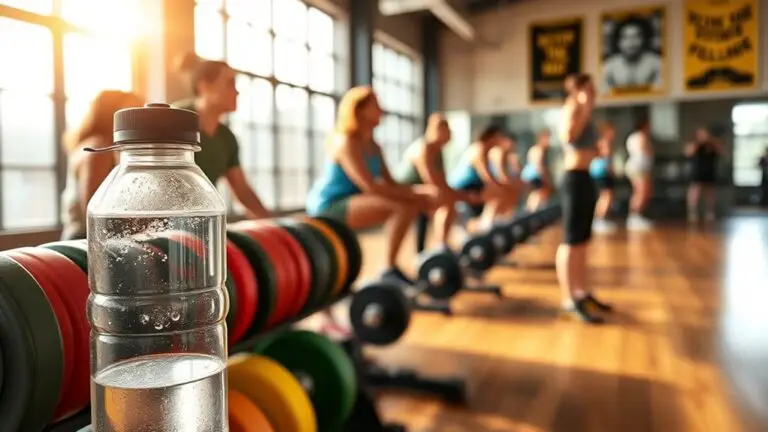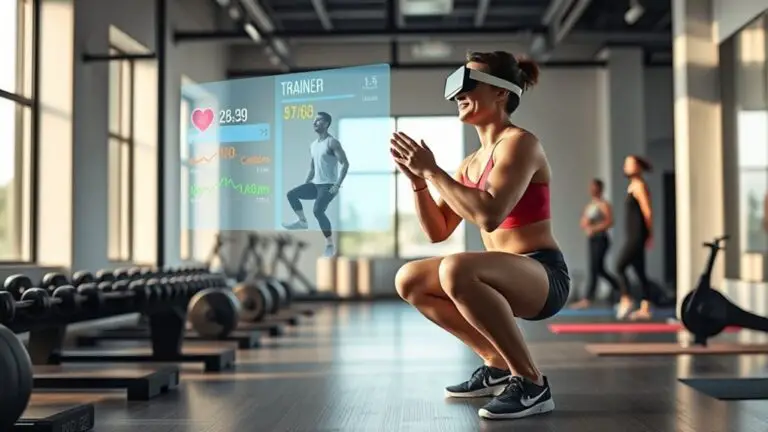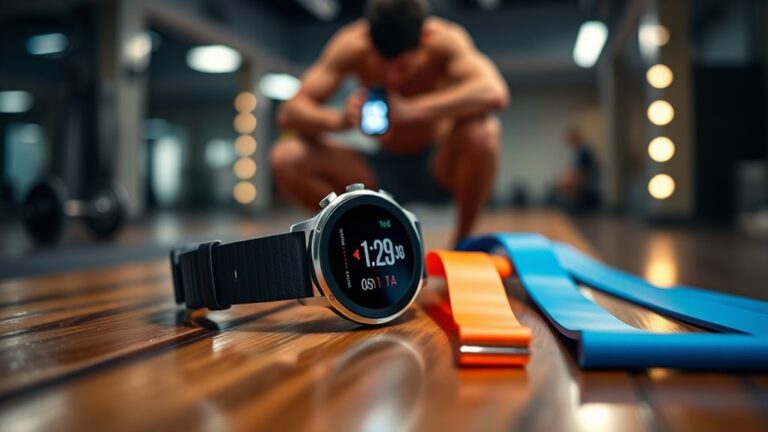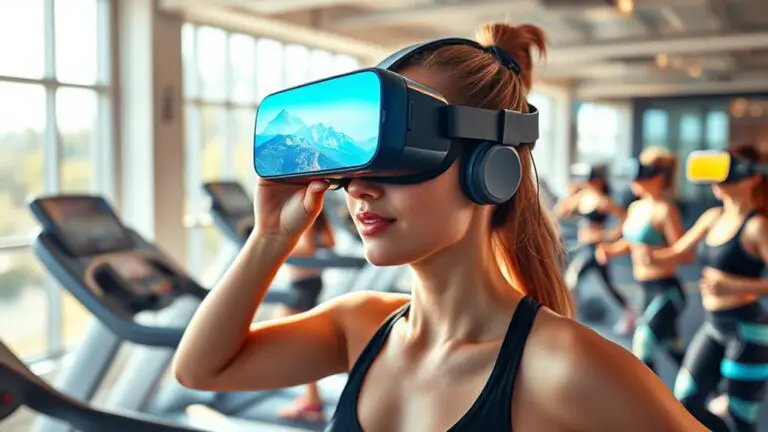How to Modify Gym Workouts for People With Disabilities
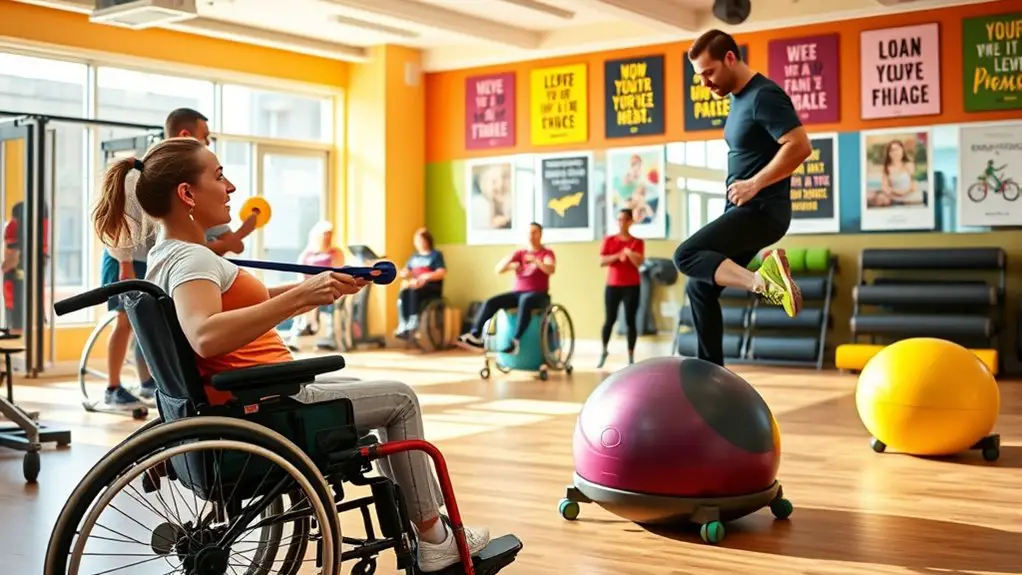
To modify gym workouts for people with disabilities, start by evaluating their unique needs and abilities. Use adaptive exercises, like seated versions and resistance bands, to make routines accessible. Choose inclusive equipment and create a welcoming environment for all. Encourage communication and feedback, as this helps tailor workouts effectively. Celebrate small victories together to build motivation and confidence. Learn how to foster an even more supportive experience that empowers individuals to thrive on their fitness journey.
Understanding Different Types of Disabilities
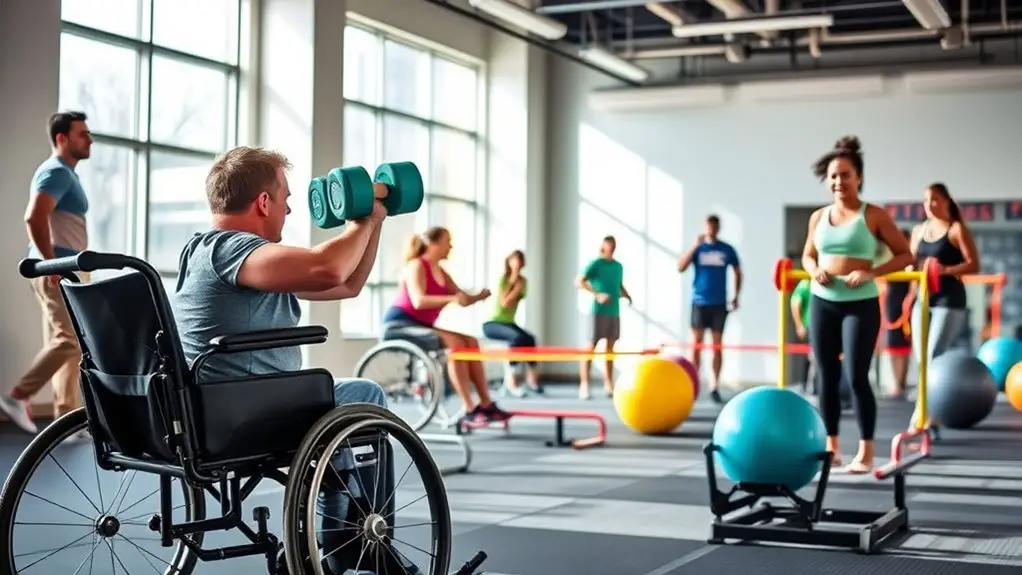
When you begin to understand different types of disabilities, you’ll see that each person’s experience is unique and can greatly impact their ability to engage in physical activities. Disabilities can range from physical limitations, like mobility issues, to cognitive challenges, affecting how individuals perceive and interact with the world. The psychological impact of living with a disability can be profound, often leading to feelings of isolation or low self-esteem.
Social considerations also play an important role; many people with disabilities face barriers in group settings, which can discourage participation in physical activities. Recognizing these factors helps foster empathy and support for individuals, empowering them to pursue their fitness goals. By understanding the various types of disabilities and their implications, you can create a more inclusive environment that encourages everyone to engage in physical activities, regardless of their challenges.
Assessing Individual Needs and Abilities
When it comes to modifying workouts, understanding your unique physical limitations is key to finding what works best for you. It’s just as important to identify activities you enjoy and set realistic goals that inspire you to stay active. By focusing on these aspects, you can create a fitness plan that truly supports your journey.
Understanding Physical Limitations
Understanding your physical limitations is essential for creating an effective workout plan that meets your needs. Everyone’s journey is unique, and recognizing your abilities helps in selecting adaptive techniques that work for you. Reflecting on personal experiences can guide you in identifying what challenges you face and what modifications might be beneficial.
Here’s a simple framework to help assess your limitations:
| Area of Limitation | Examples | Adaptive Techniques |
|---|---|---|
| Mobility | Difficulty walking | Wheelchair-accessible workouts |
| Strength | Limited upper body strength | Resistance bands |
| Endurance | Low stamina | Shorter exercise intervals |
| Flexibility | Joint stiffness | Gentle stretching routines |
Identifying Preferred Activities
What activities do you genuinely enjoy? Identifying your preferred activities is essential for creating a workout that feels rewarding and motivating. Consider your personal interests—whether it’s swimming, cycling, or trying out adaptive sports. Reflecting on what you love can guide you towards modifications that enhance your experience. Talk to trainers or fellow gym-goers about their adaptive sports journeys; you might discover new passions along the way. Additionally, think about the settings where you feel most comfortable, as this can impact your engagement. By focusing on activities that resonate with you, you’ll not only stay committed but also foster a positive relationship with fitness. Remember, it’s all about finding joy in movement that suits your unique needs and abilities.
Setting Realistic Goals
Setting realistic goals is vital, especially since everyone’s abilities and needs vary widely. When you’re engaged in goal setting, it’s important to assess your individual capabilities. This guarantees you establish realistic expectations that motivate and inspire you. Start by identifying what’s attainable, and remember that progress takes time.
| Goals | Short-Term | Long-Term |
|---|---|---|
| Fitness Level | Complete one workout/week | Achieve a specific fitness benchmark |
| Skills | Learn a new exercise | Master a complex routine |
| Well-Being | Meditate weekly | Maintain a balanced lifestyle |
| Social | Join a support group | Participate in community events |
Adapting Exercises for Various Fitness Levels
While everyone’s fitness journey is unique, adapting exercises to accommodate various fitness levels is essential for fostering an inclusive gym environment. You can start by evaluating your current abilities and setting personalized routines that work for you. Don’t hesitate to ask for help; trainers can provide valuable insights into creative modifications that make exercises more accessible.
For instance, if a traditional squat feels challenging, try a seated version or use a stability ball for support. Incorporating resistance bands can also offer a gentler approach to strength training. Remember, it’s not about how much you can lift or how fast you can run; it’s about finding what works best for your body. Additionally, consider exploring isolation exercises for biceps that can be modified to suit your needs.
Celebrate small victories along the way, and don’t forget that every bit of progress counts. By embracing your unique path, you’ll contribute to a supportive community that empowers everyone to achieve their fitness goals.
Choosing Accessible Equipment
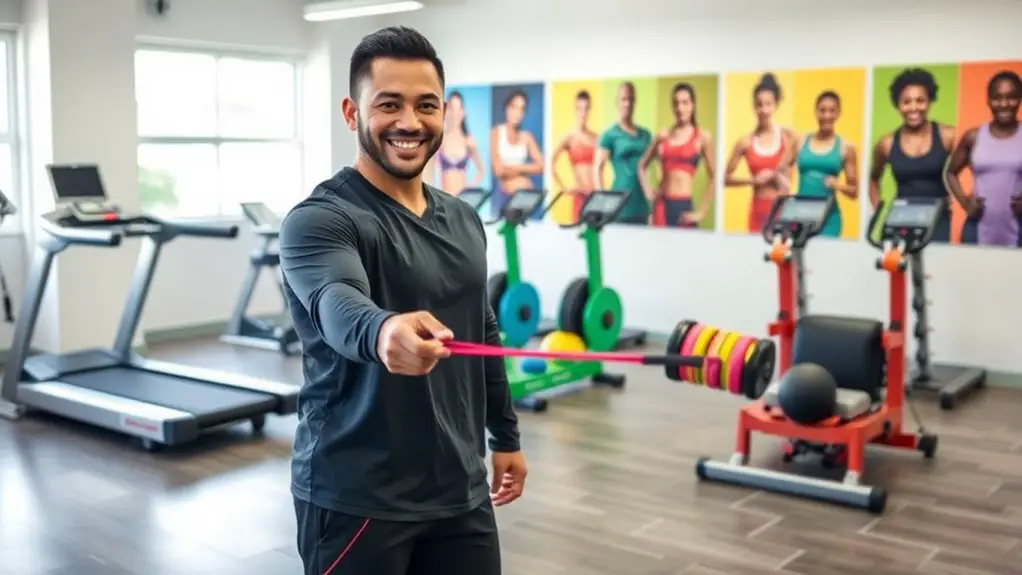
Finding the right equipment can greatly enhance your workout experience, especially when adapting to specific needs. Look for adaptive machines that cater to various abilities, ensuring you feel comfortable and confident while exercising. User-friendly designs can make a significant difference, allowing you to focus on your fitness goals without frustration.
Consider options like adjustable weights, accessible cardio machines, and resistance bands that accommodate different ranges of motion. Don’t hesitate to ask gym staff for guidance on which equipment might work best for you; they can provide valuable insights on how to use the machines safely and effectively.
Incorporating Assistive Devices
Incorporating assistive devices into your workout routine can greatly enhance your performance and comfort, making it easier to achieve your fitness goals. Assistive technology can provide essential support and make adaptive modifications more effective. Here are some devices to take into account:
- Wheelchair-Compatible Weights: These allow you to strength train without needing to transfer out of your chair.
- Resistance Bands: Great for mobility exercises, they can be adjusted for different strength levels.
- Grip Aids: Help improve your hold on weights or machines, enhancing your safety and effectiveness.
- Adaptive Mats: Provide extra cushioning and stability for floor exercises.
- Smartphone Apps: Track your workouts, set goals, and offer guided routines tailored to your needs.
Creating an Inclusive Workout Environment
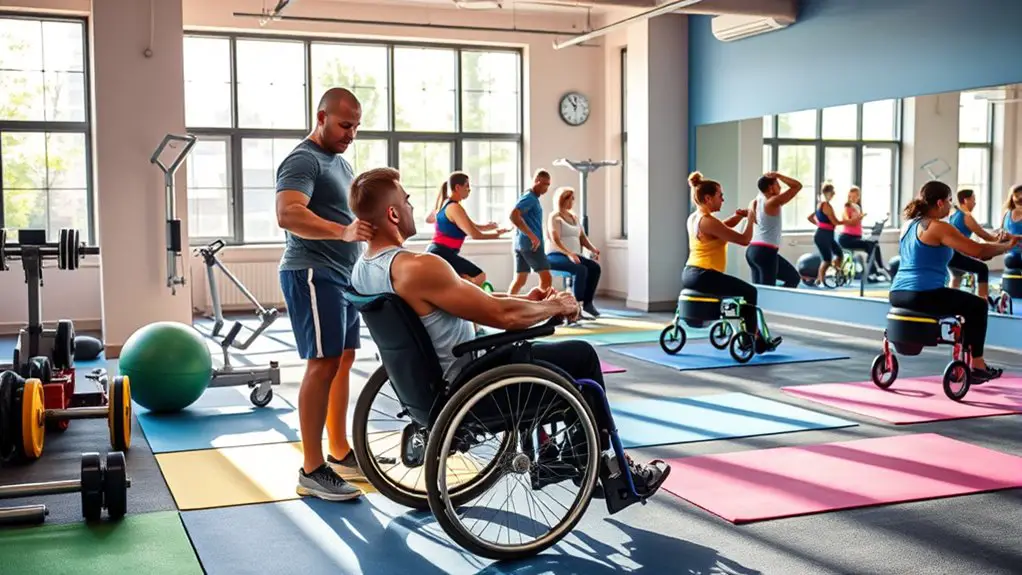
Creating an inclusive workout environment is vital for everyone, especially those with disabilities, as it fosters a sense of belonging and motivation. You can start by offering adaptive yoga classes, which not only cater to various abilities but also promote mindfulness and relaxation. Ascertain that your gym has sensory-friendly spaces—areas with reduced lighting and sound levels—where individuals can feel comfortable and focused, minimizing distractions.
Consider the layout of your gym too. Make certain equipment is accessible and clearly labeled. Having trained staff who understand the needs of individuals with disabilities can make a significant difference; they can help guide workouts and provide support.
Encouraging community activities, like group classes or workshops, can also enhance social interaction and connection. By creating a welcoming atmosphere, you’re not just accommodating diverse needs; you’re enriching everyone’s fitness journey.
Encouraging Communication and Feedback
It’s essential to foster an open dialogue about your needs and experiences in the gym. Regular check-ins with your trainers can help guarantee that your workouts remain effective and comfortable. When you share your thoughts, it not only empowers you but also helps create a more supportive environment for everyone.
Open Dialogue Importance
While maneuvering through the gym can be challenging for individuals with disabilities, fostering open dialogue about experiences and needs can greatly enhance their workout journey. Open communication and effective feedback loops create an environment where everyone feels supported. Here are some key points to reflect on:
- Encourage sharing personal experiences to understand unique challenges.
- Ask for feedback on equipment accessibility and workout modifications.
- Listen actively to suggestions for creating a more inclusive space.
- Foster a culture where all voices are valued and heard.
- Regularly check in to see how individuals feel about their progress and any necessary adjustments.
Regular Check-ins Essential
Regular check-ins are essential for ensuring individuals with disabilities feel supported and understood during their workouts. These moments of communication allow you to express your needs and preferences, fostering an environment where you can thrive. By encouraging regular feedback, trainers can adjust workouts to better suit your abilities and goals, enhancing your experience. It’s vital to establish a routine for these check-ins, whether it’s after each session or weekly, ensuring ongoing support. This not only helps you feel valued but also builds trust between you and your trainer. Remember, your comfort and progress are priorities. Openly sharing your thoughts can lead to more effective modifications, ultimately empowering you to achieve your fitness aspirations in a safe and supportive environment.
Celebrating Progress and Achievements
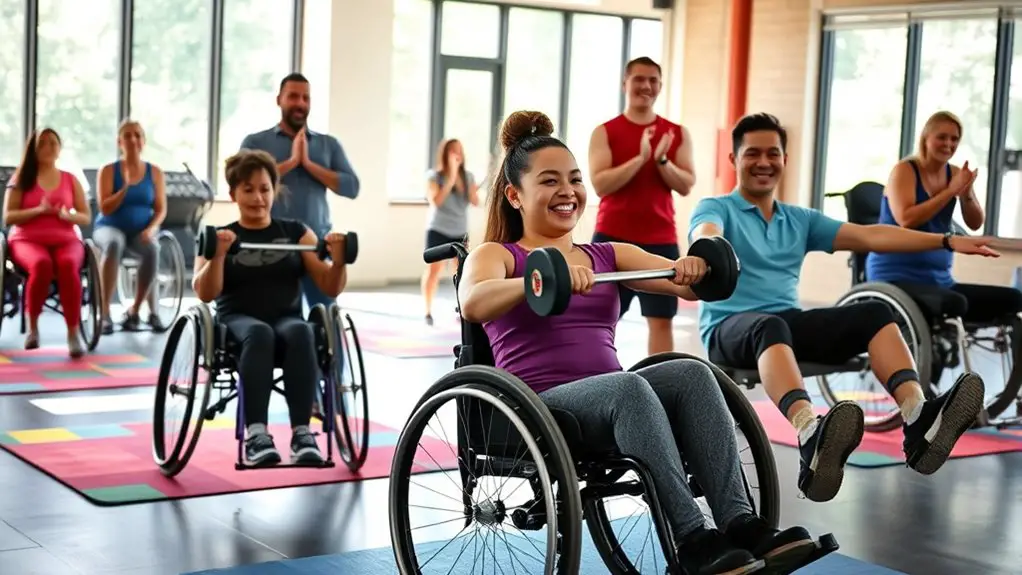
Progress is a powerful motivator, especially in the journey of adapting gym workouts for disabilities. Celebrating milestones and recognizing achievements not only boosts your confidence but also reinforces your commitment to fitness. Every small victory matters, so take time to acknowledge them.
Progress fuels motivation, making it essential to celebrate every milestone in your fitness journey, especially when adapting workouts for disabilities.
Here are some ways to celebrate your progress:
- Track improvements: Keep a journal of your workouts and note your advancements.
- Set achievable goals: Break down larger goals into smaller, manageable milestones.
- Share your journey: Connect with others in your community or on social media to inspire and be inspired.
- Reward yourself: Treat yourself to something special when you reach a goal—this could be a new workout outfit or a relaxing day off.
- Reflect on your growth: Regularly take a moment to appreciate how far you’ve come, both physically and mentally.
Every step forward counts, so embrace your journey!
Frequently Asked Questions
Can I Modify Workouts for Someone With a Temporary Injury?
Absolutely, you can modify workouts for someone with a temporary injury! Start by evaluating their condition and discussing any limitations. Consider incorporating temporary injury adaptations, like gentler movements or alternative exercises that don’t stress the injury. You might also need to make workout intensity adjustments, ensuring they’re challenging yet safe. Remember, it’s all about helping them maintain their fitness while facilitating recovery, so keep the lines of communication open and supportive.
What Are Some Common Misconceptions About Exercising With Disabilities?
When it comes to exercising with disabilities, there’re several misconceptions. Many think adaptive equipment isn’t effective or that inclusive spaces aren’t welcoming. You might believe that individuals with disabilities can’t achieve fitness goals, but that’s far from the truth! Everyone deserves the chance to work out, and with the right support and modifications, exercise can be empowering. Remember, it’s about finding what works best for you and creating an environment where everyone feels included.
How Can I Find a Qualified Trainer for Adaptive Workouts?
Finding a qualified trainer for adaptive fitness is essential for your success. Start by researching trainers who specialize in adaptive workouts and check their qualifications, such as certifications in inclusive fitness or experience working with individuals with disabilities. Don’t hesitate to ask about their approach to modifying exercises. You deserve someone who understands your unique needs and can create a supportive environment, helping you achieve your fitness goals safely and effectively.
Are There Specific Nutrition Guidelines for People With Disabilities?
When it comes to nutrition, you can’t judge a book by its cover. Everyone’s nutritional needs vary, especially if you have specific dietary restrictions. It’s important to focus on a balanced diet rich in vitamins, minerals, and proteins tailored to your unique situation. Consulting a registered dietitian can really help you navigate these waters, ensuring you get the nutrients you need while accommodating any restrictions. You deserve to feel your best!
How Can I Encourage Others to Join Adaptive Fitness Programs?
To encourage others to join adaptive fitness programs, focus on peer support and community outreach. Share success stories that highlight the benefits of these programs, showing how they’ve positively impacted lives. Organize local events or workshops to introduce adaptive fitness options, making sure to create an inclusive atmosphere. Offer to accompany potential participants to classes, fostering a sense of belonging. Your enthusiasm and support can inspire others to take that first step towards fitness and community.
